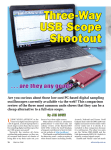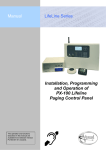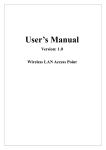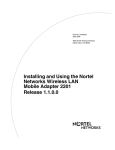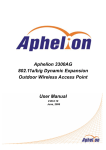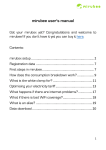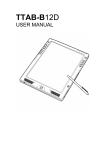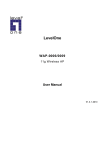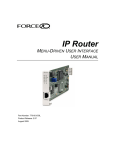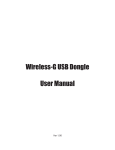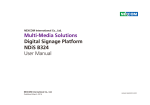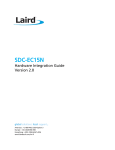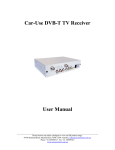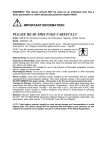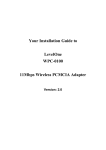Download 11Mbps Wireless LAN Card User Manual
Transcript
11Mbps Wireless LAN Card User’s Manual 2003 All rights reserved. No part of this document may be reproduced or transmitted in any form or by any means, electronic or mechanical, for any purpose, without the express written permission of the seller. Disclaimer Information in this document is subject to change without notice. The material contained herein is supplied without representation or warranty of any kind. The seller therefore assumes no responsibility and shall have no liability of any kind arising from the supply or use of this document or the material contained herein. Trademarks Microsoft and Windows are registered trademarks of Microsoft Corporation. GUI and Ethernet is a registered trademark of Xeros Corporation. All other trademarks mentioned in this document are the property of their respective owners. Date: January 2003 Part No. A150Rev03 Contents Chapter 1 Introduction ......................................................................................................................................... 1 Wireless LAN Basics ............................................................................................................................................. 2 Local Area Network (LAN).................................................................................................................................................2 Wireless Network Topologies .............................................................................................................................................3 Infrastructure Network.......................................................................................................................................................4 Chapter 2 Installing the Wireless LAN Card........................................................................................................ 7 System Requirements ........................................................................................................................................... 7 Wireless LAN Card Status LEDs............................................................................................................................ 8 The Antenna on the Wireless LAN Card (Only for Wireless LAN USB Card) .......................................................... 8 Software and Hardware Installation ....................................................................................................................... 9 Chapter 3 Wireless LAN Monitor Utility............................................................................................................. 17 Accessing the Wireless LAN Monitor Utility.......................................................................................................... 17 Note to Windows XP Users............................................................................................................................................... 18 Status.................................................................................................................................................................. 19 Basic Configuration for Ad Hoc Network ......................................................................................................................... 20 Basic Configuration for Infrastructure Network................................................................................................................ 22 I 11Mbps Wireless LAN Card User Manual Checking Link Quality (Infrastructure Mode Only)........................................................................................................... 24 Statistics ............................................................................................................................................................. 25 Site Survey.......................................................................................................................................................... 26 Encryption ........................................................................................................................................................... 28 Advanced............................................................................................................................................................ 31 Profiles................................................................................................................................................................ 33 Info...................................................................................................................................................................... 34 Chapter 4 Using Wireless Tray Icon Functions ................................................................................................ 35 Viewing Signal Strength and Speed..................................................................................................................... 35 Tray Icon Graphic Indication................................................................................................................................ 36 Other Functions................................................................................................................................................... 38 Chapter 5 Windows XP Wireless Zero Configuration Utility ............................................................................ 41 Connecting to an Access Point or Wireless LAN Card.......................................................................................... 42 Viewing Wireless Connection Status.................................................................................................................... 44 Configuring Your Wireless Properties .................................................................................................................. 45 General ........................................................................................................................................................................... 45 Wireless Networks............................................................................................................................................................ 46 To Access Certain Wireless Network Only ........................................................................................................................ 49 Authentication.................................................................................................................................................................. 50 Chapter 6 Uninstalling the Wireless LAN Card ................................................................................................. 53 Uninstalling the Wireless LAN Card Software....................................................................................................... 53 Removing the Wireless LAN Card ....................................................................................................................... 55 II Contents Chapter 7 Updating the Device Driver............................................................................................................... 57 Chapter 8 Troubleshooting ................................................................................................................................ 59 Radio Interference............................................................................................................................................... 59 Card Not Detected............................................................................................................................................... 60 Cannot Connect to Another Wireless LAN Card................................................................................................... 60 Poor Link Quality................................................................................................................................................. 61 Cannot Connect to Access Point ......................................................................................................................... 61 Appendix A Limited Warranty............................................................................................................................ 63 Wireless LAN Hardware ...................................................................................................................................... 63 Wireless LAN Software........................................................................................................................................ 64 Appendix B Regulatory Compliance ................................................................................................................. 65 FCC Part 15 Declaration of Conformity (DoC)...................................................................................................... 65 FCC Rules and Regulations - Part 15 .................................................................................................................. 66 FCC Radiation Exposure Statement .................................................................................................................... 67 Appendix C Setting Up TCP/IP........................................................................................................................... 69 For Windows 98/ME ............................................................................................................................................ 69 For Windows 2000/XP......................................................................................................................................... 71 Appendix D Specification .................................................................................................................................. 73 Software.............................................................................................................................................................. 73 III 11Mbps Wireless LAN Card User Manual Hardware ............................................................................................................................................................ 75 Glossary ................................................................................................................................................................ 81 IV Contents List of Figures Figure 1-1 Figure 1-2 Figure 1-3 Figure 3-1 Figure 3-2 Figure 3-3 Figure 3-4 Figure 3-5 Figure 3-6 Figure 3-7 Figure 3-8 Figure 3-9 Figure 5-1 Figure 5-2 Figure 5-3 Figure 5-4 Figure 5-5 Figure 5-6 Figure 5-7 Ad-Hoc Mode................................................................................................................................. 3 Infrastructure Mode ........................................................................................................................ 4 Roaming Across Multiple Access Points ......................................................................................... 5 Ad-Hoc Mode Configuration ......................................................................................................... 21 Infrastructure Mode Configuration ................................................................................................ 23 Infrastructure Mode Link Status.................................................................................................... 24 Wireless LAN Monitor Utility – Statistics ....................................................................................... 25 Wireless LAN Monitor Utility – Site Survey.................................................................................... 27 Wireless LAN Monitor Utility – Encryption..................................................................................... 30 Wireless LAN Monitor Utility – Advanced...................................................................................... 32 Wireless LAN Monitor Utility – Profiles.......................................................................................... 33 Wireless LAN Monitor Utility – Info................................................................................................ 34 Windows XP Configuration Utility-Connect to Wireless Network.................................................... 43 Windows XP- Connection Status .................................................................................................. 44 Windows XP Connection Properties –General .............................................................................. 46 Windows XP Connection Properties-Wireless Networks ............................................................... 47 Windows XP-Add Preferred Networks .......................................................................................... 48 Windows XP Configuration Utility-Set up Network to Aceess ........................................................ 50 Windows XP Connection Properties -Authentication ..................................................................... 51 V 11Mbps Wireless LAN Card User Manual About This User’s Manual This manual was written for two models: ! ! PCMCIA Wireless LAN Card USB Wireless LAN Card For brevity, throughout this manual Wireless LAN Card is used to indicate both models. Also, the following terms/abbreviations are used interchangeably: ! Access Point-AP ! Wireless LAN-WLAN ! Ethernet network-LAN-network This User’s Manual contains information on how to install and configure your Wireless LAN Card. From now on, we will guide you through the correct configuration steps to get your device up and run. VI Chapter 1 Introduction This Wireless LAN Card is an IEEE 802.11b Wireless LAN PCMCIA/USB adapter. It allows your computer to connect to a wireless network and to share resources, such as files or printers without being bound to the network wires. Operating in 2.4GHz Direct Sequence Spread Spectrum (DSSS) radio transmission, the Wireless LAN Card transfers data at speeds up to 11Mbps. Both Ad-Hoc and Infrastructure mode are supported. For network security concern, 64/128-bit Wired Equivalent Protection (WEP) algorithm is used. In addition, its standard compliance ensures that it can communicate with any 802.11b networks. 1 11Mbps Wireless LAN Card User Manual Wireless LAN Basics This section conations some Wireless LAN basics to help you better understand how the product work together to create a wireless network. Local Area Network (LAN) Simply put, a LAN is a network that exists in a relatively limited area. A network is two or more computers connected together sharing files and peripheral devices such as printers. The Wireless LAN Card allows you to interact with other computers without having to run cables normally associated with networks. This lets you move your computer around while staying connected to your network. There are two ways to use the Wireless LAN Card. One way is to connect directly to one or more Wireless LAN Card equipped computers, forming an Ad Hoc wireless network. The second way is to connect to an Access Point that gives you access to an existing wired LAN, forming an Infrastructure wireless network. 2 Chapter 1 Introduction Wireless Network Topologies The 802.11 standard defines two wireless modes: Infrastructure mode and Ad Hoc mode. Ad Hoc Network An Ad Hoc network offers peer to peer connections between wireless stations that are in range of each other. The stations communicate directly with each other without using an Access Point or any connection to a wired network. This mode is useful for quickly and easily setting up a wireless network anywhere that a wireless infrastructure does not exist or is not required for services. In an Ad Hoc network, all wireless stations must have the same SSID, channel and WEP keys (if enabled) to communicate with each other. Figure 1-1 Ad-Hoc Mode 3 11Mbps Wireless LAN Card User Manual Infrastructure Network An Infrastructure wireless network consists of at least one Access Point connected to the wired network infrastructure and a set of wireless end stations. The AP acts as a gateway, linking the wireless network to a wired LAN. As a result, wireless stations have access to all of the features of your wired LAN including e-mail, Internet, network printers and files server access. Figure 1-2 4 Infrastructure Mode Chapter 1 Introduction Roaming Between Multiple Access Points For large environments, multiple Access Points can be implemented to extend the wireless service coverage area for seamless wireless access. It allows wireless clients to roam from one AP to another while maintaining the wireless connectivity at all times. A wireless client wandering across multiple APs will automatically change the operating radio frequency as required. In a roaming network, all APs and wireless clients must have the same Service Set Identity (SSID) and security setting (if enabled). Alternatively the mobile station may use an SSID of “any” to associate with any available AP, regardless of the AP’s SSID. Roaming among different Access Points is controlled automatically to maintain the wireless connectivity at all times. Figure 1-3 Roaming Across Multiple Access Points 5 Chapter 2 Installing the Wireless LAN Card This chapter describes the installation process for the driver and software for the Wireless LAN Card. Proper driver installation is to allow the device to operate on your host computer while the utility software, Wireless Client Manager, is to help you configure and monitor your Wireless LAN Card. System Requirements To use the Wireless LAN Card, your computer must meet the following minimum requirements: ! ! ! ! Windows 98(SE)/Me/2000/XP 32 MB of RAM, additional memory recommended Standard PCMCIA slot/USB port UL listed I.T.E. computers. 7 11Mbps Wireless LAN Card User Manual Wireless LAN Card Status LEDs The two LEDs on the Wireless LAN Card indicate connection status and data transfer operation status described as below: LED Power Color Red State On Description The adapter is plugged into the PCMCIA slot/USB port of your computer. Activity Green Blinking Transmission mode. The faster the LED blinks, the higher the data exchange rate. The Antenna on the Wireless LAN Card (Only for Wireless LAN USB Card) The USB adapter comes with one powerful antenna. You can rotate the antenna from 0 to 180 degrees to adjust its range and the connection quality. Caution: Do not rotate the antenna more than 180 degrees, otherwise permanent damage may be caused. 8 Chapter 2 Installing the Wireless LAN Card Software and Hardware Installation Caution: Do not connect the Wireless LAN Card device to your computer before installing its software. If this happens, the Windows PnP function will detect the PCMCIA/USB device and issue a dialog box requesting its driver. Click Cancel to quit the wizard and unplug the Wireless LAN Card. Follow these steps to install the Wireless LAN Card: 1. Close all Windows programs that are running. 2. Insert the provided Software Utility CD into your CD-ROM drive and select Utility&Driver. Or, run Setup.exe from D:\Utility&Driver folder of the Software Utility CD where D is the drive letter. When the welcome screen pops up, click Next. 9 11Mbps Wireless LAN Card User Manual 10 3. When the License Agreement screen appears, click Yes. 4. For quick installation, select Typical and click Next. Then skip to step 11. For custom installation (to select the parameters that you would like to use), select Custom and click Next to go to next step. Chapter 2 Installing the Wireless LAN Card 5. To install the software to the default destination folder, click Next. If you are to install the software to a different folder, click Browse to select another folder, and then click Next. 6. If required, you may type a new folder name for the program icons to be added to the Program Folder. Then click Next to continue. 11 11Mbps Wireless LAN Card User Manual 12 7. Select the network type you prefer and then click Next. 8. Enter the SSID of the wireless network you wish to connect to. Then click Next. Chapter 2 9. Installing the Wireless LAN Card This step is for Ad Hoc network type only. For Ad Hoc mode network, specify a channel number for the Wireless LAN Card. 10. If the settings listed are correct, click Next. Otherwise, click Back to modify your settings. 13 11Mbps Wireless LAN Card User Manual The power LED on the Wireless LAN Card will light when the Wireless LAN Card is connected to your computer. 11. Later, the following screen will pop up to ask you to insert your wireless card into the PCMCIA slot / USB port of your computer. Please do as the dialog request. 12. Subject to your Windows OS, the following situation may occur: For Windows 98(SE) You will be prompted for Windows 98 CD. Click OK. Then enter the path to your Windows 98(SE) CD (if Windows 98 CD files are not in you host computer, you need to insert the CD into your CD-ROM at this step) and click OK. For Windows 2000 If you are prompted with the Digital Signature not Found alarm message, just click Yes to continue with the installation. For Windows XP a. Upon hardware detection, Windows OS will pop up a dialog requesting for driver. Select Install the software automatically and click Next. b. If Windows logo compatibility message appears, click Continue Anyway to proceed with the installation. c. Click Finish. 14 Chapter 2 Installing the Wireless LAN Card 13. Click Finish to complete the installation. Now you are done with the installation procedure. Proceed to next chapter to configure or fine-tune your Wireless LAN Card settings. Note: If you need to set up the TCP/IP properties of your Wireless LAN Card, refer to “Appendix C Setting Up TCP/IP” for details. 15 Chapter 3 Wireless LAN Monitor Utility The configuration of the Wireless LAN Card is done through the Wireless LAN Monitor Utility. This utility also includes a number of tools to display current statistics and status information pertaining to your Wireless LAN Card. See the appropriate subsection as required. Accessing the Wireless LAN Monitor Utility The Wireless LAN Monitor Utility is launched automatically with its icon located on the system tray. If the utility is not launched, manually start the monitor by selecting Start > Programs > IEEE 802.11b Wireless LAN > IEEE 802.11b Wireless LAN Utility. You can access the Wireless LAN Monitor Utility by any of the following methods: ! Double-click the Wireless LAN Monitor Utility tray icon on the system tray 17 11Mbps Wireless LAN Card User Manual ! Right-click the tray icon and select Settings from the context menu. Note to Windows XP Users Under Windows XP, if you are launching the Wireless LAN Monitor Utility for the first time, you will find that you are only allowed to view the statistics and version information. Configuration fields and buttons are dimmed. This is because that the Windows XP built-in Wireless Zero Configuration Utility overrides the management of the Wireless LAN Monitor Utility. If you want to disable the Windows XP Wireless Zero Configuration Utility and have your device managed by the Wireless LAN Monitor Utility, proceed as follows: 1. Double-click the Windows XP wireless tray icon and then click Advanced (or Properties) > Wireless Networks. Windows XP wireless icon 18 Manufacturer’s wireless utility tray icon Chapter 3 Wireless LAN Monitor Utility 2. On the Wireless Networks tab, uncheck the Use Windows to configure my wireless network settings box and click OK. If you need to revert back to using Windows XP Wireless Zero Configuration Utility, just go to the Wireless Networks tab and check the Use Windows to configure my wireless network settings box and click OK. Status The Status tab displays the current status of your Wireless LAN Card. It also allows you to re-configure the Wireless LAN Card setting. Even though you might have configured the settings during the driver and utility installation, it is possible that you want to change your operating mode between Infrastructure or Ad-Hoc mode and fine-tune other settings. You can connect your computer to a network in one of the following two ways. Refer to sequential sections for configuration: Ad Hoc Connecting to other Wireless LAN Card equipped computers, forming a wireless network. Infrastructure Connecting to a wired/wireless network through an Access Point. 19 11Mbps Wireless LAN Card User Manual Basic Configuration for Ad Hoc Network 1. In the taskbar, double-click the Wireless LAN Monitor Utility icon to display the Wireless LAN Monitor Utility dialog box. Make sure to select the desired profile from the Current Profile list. 2. Click the Status tab and then click Change to make the setting items configurable. 3. From the Operating Mode list, select Ad-Hoc. 4. From the Channel list, select the channel number which you want to use. 5. In the SSID field, type the Service Set ID (SSID) of the Wireless LAN group. A network name is mandatory for Ad Hoc mode. All wireless clients must use the same SSID in order to communicate with each other. 6. From the Tx Rate list, select the transmit rate to use. If Auto is selected, the wireless adapter will adaptively adjust its data rate from 11 Mbps to 5.5, 2 or 1 Mbps as the signal strength warrants. 7. From the Radio list, select On to enable the radio signal. 8. Click Submit. 9. Click Exit if you wish to exit the utility. If WEP encryption is enabled in the Ad Hoc network you are going to connect to, proceed to configure the Encryption tab as described in the “Encryption” section. 20 Chapter 3 Wireless LAN Monitor Utility Figure 3-1 Ad-Hoc Mode Configuration 21 11Mbps Wireless LAN Card User Manual Basic Configuration for Infrastructure Network 1. In the taskbar, double-click the wireless tray icon to display the Wireless LAN Monitor Utility dialog box. Make sure to select the desired profile from the Current Profile list. 2. Click the Status tab and then click Change to make the setting items configurable. 3. From the Operating Mode list, select Infrastructure. 4. In the SSID field, type the SSID of the Access Point you are going to connect to. The wireless client must use the same SSID as the Access Point in order to communicate with other computers via the Access Point. Note that under Infrastructure mode, if the SSID field is left blank or filled in with the special SSID name “any”, your Wireless LAN Card will connect to the first compatible and “open” AP with the best signal strength within the connection range. It allows your Wireless LAN Card to wander across networks with different SSID. 22 5. From the Tx Rate list, select the transmit rate to use. If Auto is selected, the wireless adapter will adaptively adjust its data rate from 11 Mbps to 5.5, 2 or 1 Mbps as the signal strength warrants. 6. From the Int. Roaming list, select whether to enable the roaming feature. 7. From the Radio list, select On to enable the radio signal. 8. Click Submit. Chapter 3 Wireless LAN Monitor Utility 9. Click Exit if you wish to exit the utility. If WEP encryption is enabled in the Infrastructure network you are going to connect to, proceed to configure the Encryption tab as described in the “Encryption” section. Figure 3-2 Infrastructure Mode Configuration 23 11Mbps Wireless LAN Card User Manual Checking Link Quality (Infrastructure Mode Only) To check the link quality of the connection in Infrastructure mode, double-click the Wireless LAN Monitor icon on the taskbar to display the Wireless LAN Monitor Utility dialog box. Then click the Status tab. The connection status is shown at the bottom of the dialog box. Status: Displays the BSSID of the Access Point to which your Wireless LAN Card is associated. If may also diplay the current association status, such as scanning or authenticating. Signal Strength: Displayed as percentages using active progress indicators that change as the network radio signal fluctuates. Link Quality: Link Quality categories are defined as follows: Link Quality Range(%) Poor 0-29 Fair 30-59 Good 60-89 Excellent 90-100 Figure 3-3 24 Infrastructure Mode Link Status Chapter 3 Wireless LAN Monitor Utility Statistics The Statistics tab allows you to view the available statistic information, including the Data Packets, Management Packets and Rejected Packets. Tx indicates data transmitted whereas Rx indicates data received. Optionally you can click the Reset button to reset the statistic counters to zero. Figure 3-4 Wireless LAN Monitor Utility – Statistics 25 11Mbps Wireless LAN Card User Manual Site Survey Site Survey function scans the wireless network searching for available Access Points and wireless stations (Ad-hoc mode) within the range of the card. Available stations are listed with the following information: BSSID: Basic Service Set ID. It is actually the MAC address of the Access Point/wireless station (Ad-hoc mode). It can be used to identify the stations when they have the same SSID. SSID: Service Set ID. Displays the current SSID of the Access Point or Ad Hoc network. Signal: Shows the signal strength ratio. The higher the ration, the more powerful the signal received by your Wireless LAN Card. It helps you optimize the placement of your wireless station when roaming throughout the wireless network environment Channel: The operating radio channel number. WEP: Displays if encryption is enabled or disabled on the Access Point/wireless station. Type: Indicates whether the operating mode is Infrastructure or Ad-Hoc. Re-Scan: This button allows you to update the list. 26 Chapter 3 Wireless LAN Monitor Utility Connecting to Desired Site by Site Survey Utility If you want to connect to any of the Access Point(s) and Ad-Hoc Station(s) listed, double-click on your choice (on the BSSID field). The utility will take you back to the Status tab showing the parameters of the connection newly established. Figure 3-5 Wireless LAN Monitor Utility – Site Survey 27 11Mbps Wireless LAN Card User Manual Encryption Encryption technology is used to enhance wireless media security. Your encryption settings must match those used by the Access Points or wireless stations (Ad-hoc mode) in your network, or your computer will be unable to communicate with others through the network. If you are not going to use encryption, got to the Encryption tab and select Disabled from the Encryption drop-down menu. Yet, if you need to enable encryption, please do the following: 1. Select the Encryption tab from the Wireless LAN Monitor Utility. 2. Select 64 Bit or 128 Bit as your encryption type. 3. For flexibility, you can enter the WEP keys in either HEX or ASCII format. Enable the preferred format and then enter the key values in the Key #1-4 fields. Note that when using HEX format, only digits 0-9 and letters A-F, a-f are allowed. Valid key length for each encryption type is as below: HEX Format ASCII Format 64 Bit 10 hexadecimal digits 5 ASCII characters 128 Bit 26 hexadecimal digits 13 ASCII characters Note that the four keys, including the one selected as Default Key, are used to decrypt the data you receive. 28 Chapter 3 Wireless LAN Monitor Utility 4. From the Default Key list, select one of the four keys to encrypt the data you are going to transmit. 5. In the Mode list, select Mandatory or Optional as required. Mandatory: If selected, you need to set the WEP keys to have your station use WEP encryption to communicate with other stations. As a result, any other station within the wireless network will need to use WEP encryption to establish connection with your station. Optional: If selected, your station can communicate with other stations within the wireless network regardless if they use WEP or not. 6. Select Open System, Shared Key or Auto as the Authentication Type. Your authentication type must be the same as those on the Access Point/wireless client (Ad-Hoc mode) with which you want to associate. 7. To have the new settings take effect, click the Submit. Then click Exit to exit the utility. Note: To use data encryption, all the wireless stations and/or Access Points must use the same encryption key values. For example, if you use Key #1 on your Wireless LAN Card and a value is assigned, then the same value must be assigned to Key 1 for all other client stations. 29 11Mbps Wireless LAN Card User Manual Figure 3-6 30 Wireless LAN Monitor Utility – Encryption Chapter 3 Wireless LAN Monitor Utility Advanced Advanced feature allows you to change advanced configuration settings: Preamble Type, Fragmentation Threshold, RTS/CTS Threshold and Power Save. Preamble Type: The preamble is part of the IEEE 802.11b physical layer specification. All 802.11b devices are mandatory to support the long preamble format, but may optionally support the short preamble. This Wireless LAN Card supports the short preamble. The Short option allows to communicate with other 802.11b devices which support short preamble to boost the throughput. The Long option is typically used in a “noisy” network. Make sure to use the appropriate preamble type according to your network environment. Fragmentation Threshold: The fragmentation threshold, which is specified in bytes, determines whether packets will be fragmented and at what size. On an 802.11 wireless LAN, packets exceed the fragmentation threshold are fragmented, i.e., split into, smaller units suitable for the circuit size. Packets smaller than the specified fragmentation threshold value are not fragmented. RTS/CTS Threshold: When set (in bytes), it specifies the packet size beyond which the Wireless LAN Card invokes its RTS/CTS mechanism. Packets that exceed the specified RTS threshold trigger the RTS/CTS mechanism. The NIC transmits smaller packets without using RTS/CTS. 31 11Mbps Wireless LAN Card User Manual Power Save: If enabled, your Wireless LAN Card will go the sleep mode and during which data communication will be interrupted. For uninterrupted data communication, you may leave this option blank to disable power saving feature. Changing the Fragmentation or RTS/CTS Threshold By default, the Fragmentation and RTS/CTS Threshold are disabled. To change the Fragmentation/RTS Threshold parameters, move the slide bar with your mouse, or click on the slide bar and then use the right and left arrow keys of your keyboard to select an exact number. Figure 3-7 32 Wireless LAN Monitor Utility – Advanced Chapter 3 Wireless LAN Monitor Utility Profiles The Profiles feature allows you to create multiple profiles to reflect specific WLAN settings for each place you may roam. You can easily retrieve the required profile from the Current Profile drop-down list. Selecting a profile from the Existing profile list displays the corresponding parameters on the bottom of this tab. To create a new profile, click New and then enter the name for the profile. If you need to customize the settings for certain profile, you must select the profile from the Current Profile drop-down list, go to the Status tab and then click Change to change the settings. Figure 3-8 Wireless LAN Monitor Utility – Profiles 33 11Mbps Wireless LAN Card User Manual Info The Info tab displays the basic information about the device, including the Driver, Firmware and Application version and the MAC address of your Wireless LAN Card. Use the Exit button if you wish to exit the application. Figure 3-9 34 Wireless LAN Monitor Utility – Info Chapter 4 Using Wireless Tray Icon Functions Viewing Signal Strength and Speed Whenever you start Windows, the Wireless LAN Monitor Utility is launched automatically with its icon loaded on the system tray, located near the clock on the task bar. While connected, you can place your cursor over the icon to see the pop-up text that gives link information about the current SSID, speed and signal strength. 35 11Mbps Wireless LAN Card User Manual Tray Icon Graphic Indication The graphic of the wireless icon changes to indicate your wireless connection quality. The Wireless LAN Monitor Utility icon color is green or yellow to indicate whether your Wireless LAN Card is in Infrastructure or Ad Hoc mode respectively. Possible radio connection quality and procedures to take are described in the table below: Graphic 36 Signal Strength Radio Connection Quality 90-100% Excellent radio connection Your Wireless LAN Card has an excellent radio connection with the network, allowing excellent network communication at the highest transmit rate. 60-89% Good radio connection Your Wireless LAN Card has a good radio connection with the network, allowing normal network communication. 30-59% Fair radio connection The radio signal is fair. You can move your device closer to your target Access Point for better signal strength. 0-29% Poor radio connection. The radio signal is very weak. Save your profiles and move closer to the target Access Point. Chapter 4 Using Wireless Tray Icon Functions Graphic Signal Strength Radio Connection Quality N/A No radio connection If “X” is placed over the icon, radio signal is disabled. It may due to you are out of range of the wireless network, the SSID can not be found or your WEP encryption doesn’t match your target Access Point and data frame error occurs. Move your device closer to your target Access Point or verify your SSID or WEP settings. Your Wireless LAN Card has been set to operate in Ad Hoc mode. Ad Hoc mode is activated and your Wireless LAN Card is resetting or initializing. 37 11Mbps Wireless LAN Card User Manual Other Functions Right-clicking the icon displays the context menu as shown below: Each item on the context menu is described as below: Active Profile: Displays the current active profile and allows you to switch to another configuration profile. Always on top: Sets the Wireless LAN Monitor Utility window always on top to prevent it from being covered by other windows. Settings: Pops up the Wireless LAN Monitor Utility with the Status tab displayed. About: Pops up the Wireless LAN Monitor Utility with the Info tab displayed. 38 Chapter 4 Using Wireless Tray Icon Functions Exit: Disables the Wireless LAN Monitor Utility and the system tray icon. To re-launch the utility, select Start > Programs > IEEE 802.11b Wireless LAN > IEEE 802.11b Wireless LAN Utility. 39 Chapter 5 Windows XP Wireless Zero Configuration Utility Windows XP provides built-in Wireless Zero Configuration Utility for wireless configuration and monitor. Windows XP Wireless Zero Configuration Utility is enabled by default. When it is active, it will override the management of the Wireless LAN Monitor Utility. In this situation, when you open the Wireless LAN Monitor Utility, you are only allowed to view the statistics and version information. Configuration fields and buttons are dimmed. This chapter only provides the essential instructions on using Windows XP wireless utility to get your wireless network established. For more information please refer to Windows XP on-line help. Note: If you want to disable Wireless Zero Configuration Utility and have your Wireless LAN Card managed by the manufacturer’s Wireless LAN Monitor Utility, please refer to “Note to Windows XP Users” in Chapter 3. 41 11Mbps Wireless LAN Card User Manual Connecting to an Access Point or Wireless LAN Card To connect to an existing Access Point/Wireless LAN Card, take out the following steps: 1. Right-click the Wireless Connection icon on the system tray and select View Available Wireless Networks from the context menu. Note: Depending on whether your wireless network is established, the context menu may come with different items. 2. 42 When the Connect to Wireless Network window pops up, you will see all the Access Points or Wireless LAN Cards that are available in the air. Select the wireless network you want to connect to . Chapter 5 Figure 5-1 Windows XP Wireless Zero Configuration Utility Windows XP Configuration Utility-Connect to Wireless Network 3. If the target Access Point/Wireless LAN Card has been set with WEP key, you must enter the same WEP key in the Network key field. Otherwise, leave it blank. 4. Click Connect, then you will join the target network and this dialog window will disappear. When your wireless connection is established, the connection icon appears as below: 43 11Mbps Wireless LAN Card User Manual Note: If the wireless connection can’t be established, double-click the connection icon and then click Properties. Go to Authentication tab first to make sure that you use the correct authentication type for the Wireless LAN Card. For more information, refer to “Authentication” on page 50. Viewing Wireless Connection Status After you successfully connect to the Access Point or Wireless LAN Card, double-click the icon in the system tray again. This will open the Wireless Network Connection Status window where you can see the general data of the Wireless LAN Card, such as Status, Duration, Speed, Signal Strength, etc. Figure 5-2 44 Windows XP- Connection Status Chapter 5 Windows XP Wireless Zero Configuration Utility Configuring Your Wireless Properties To configure your wireless properties, open the Wireless Network Connection Status window as described above, and then click the Properties button. This will open the Wireless Network Connection Properties window which allows you to configure more detailed items of the Wireless LAN Card. The following describes each tab of the properties window to help you do more settings of the Wireless LAN Card. General This tab allows you to specify the network methods to be used with your Wireless LAN Card. The network policy depends on your wireless network. For TCP/IP protocol, you should configure its properties as instructed by your network administrator. For more information on TCP/IP setting, please refer to “Appendix C Setting Up TCP/IP” on page 69. 45 11Mbps Wireless LAN Card User Manual Figure 5-3 Windows XP Connection Properties –General Wireless Networks This tab contains two sections: Available networks and Preferred networks described as below. 46 Chapter 5 Windows XP Wireless Zero Configuration Utility Under Available networks section, you can also see all the Access Points and Wireless LAN Cards available in the air. Clicking Refresh will update the list of Access Points and Wireless LAN Cards. Figure 5-4 Windows XP Connection Properties-Wireless Networks Under Preferred networks section, you can add any wireless networks that you wish to connect to. To do this, just click Add to add more Access Points or Wireless LAN Cards to the list. After you click the Add button, the Wireless Network Properties window pops up. Type your network name (SSID) and, if needed, the wireless network WEP settings. Once the 47 11Mbps Wireless LAN Card User Manual Access Point or Wireless LAN Card that you want to connect to has been set with WEP key, you must type the same WEP key as the Access Point’s or Wireless LAN Card’s. Figure 5-5 Windows XP-Add Preferred Networks After you add several profiles into Preferred networks, you can change the order in which connection attempts to preferred networks are made. Just select the target wireless network and click Move up or Move down to move it to a desired position. 48 Chapter 5 Windows XP Wireless Zero Configuration Utility To Access Certain Wireless Network Only If you just want to access certain wireless network type, click the Advanced button on the Wireless Networks tab to open the Advanced window. You can choose to connect to the following networks: • Any available network (access point preferred) • Access point (infrastructure) • Computer-to-computer (Peer-to-Peer Group) The default network type is Any available network ( access point preferred). In this network type, your device will connect to any Access Points or Wireless LAN Cards available in the air but Access Point always demands higher connection attempt priority. Once you finish the advanced setting, your wireless station will then connect to your desired network and the connected network will be listed under Available networks. 49 11Mbps Wireless LAN Card User Manual Figure 5-6 Windows XP Configuration Utility-Set up Network to Aceess Authentication This tab allows you to configure the authentication settings of your Wireless LAN Card. The most important setting for the Wireless LAN Card is to disable Enable network access control using IEEE802.1X to ensure successful connection between the Wireless LAN Cards and Access Points or other Wireless LAN Cards. You must disable this function for any reason. Otherwise, there may be some problems happening during connection. For other settings, we recommend you keep the default settings to minimize the problems during connection. 50 Chapter 5 Windows XP Wireless Zero Configuration Utility Make sure to clear the Enable network access control using IEEE802.1X check box to ensure successful connection. Figure 5-7 Windows XP Connection Properties -Authentication 51 Chapter 6 Uninstalling the Wireless LAN Card Should you need to uninstall the Wireless LAN Card and application software for any reason,, you should uninstall the associated software and then remove the hardware from your computer. Please proceed as follows. Uninstalling the Wireless LAN Card Software Note: Before uninstalling the Wireless LAN Card software, please disable the utility by right-clicking the utility tray icon and select Exit from the context menu. The icon will disappear to indicate that the utility is not in operation. 53 11Mbps Wireless LAN Card User Manual 54 1. Close all programs that are currently running. 2. Click the Windows Start button, point to Programs, IEEE 802.11b Wireless LAN and then click Remove IEEE 802.11b Wireless LAN Utility. 3. Click OK to proceed with the software removal procedure. Chapter 6 4. Uninstalling the Wireless LAN Card Click Finish to complete the software uninstallation. Removing the Wireless LAN Card Make sure that you have removed the software before you proceed. The Wireless LAN Card complies with the PCMCIA/USB standard that allows devices to be inserted into and removed from the computer’s PCMCIA slot/USB port when the computer is powered on. For USB Wireless LAN Card, just remove the card from your PC’s USB port. For PCMCIA device, it is recommended that you follow the standard Windows procedure for disconnecting a PCMCIA device from your computer. The following steps assume a Windows 98 environment: 55 11Mbps Wireless LAN Card User Manual 56 1. On the system tray, right-click the PCMCIA icon, and then click Adjust PC Card Properties. 2. Select the Wireless LAN Card which you want to remove, click Stop. 3. When the message appears that tells you it is safe to remove device, click OK and remove the Wireless LAN Card from the computer. 4. Click OK to exit the PC Card (PCMCIA) Properties window. Chapter 7 Updating the Device Driver Periodically, you may need to upgrade the Wireless LAN Card’s driver when a newer version is available. Check our website for information about the latest driver upgrades. When you have finished the download procedure, please follow as below to update the device driver. 1. Uninstall the Wireless LAN Card as described in Chapter 6. Follow the steps to remove the Wireless LAN Card and then uninstall the software. 2. Install the new driver you have downloaded. Refer to Chapter 2 for detailed instructions. Once you finish installing the new driver, the updating is complete. 57 Chapter 8 Troubleshooting Radio Interference You may be able to eliminate any interference by trying the following: ! ! ! ! ! Reseat the Wireless LAN Card. Increase the distance between the wireless computers and the device causing the radio interference. Plug the computer equipped with the Wireless LAN Card into an outlet on a different branch circuit from that used by the affecting device. Consult the dealer or an experienced radio technician for help. Keep the computer with the Wireless LAN Card away from the microwave oven and large metal objects. 59 11Mbps Wireless LAN Card User Manual Card Not Detected If the Wireless LAN Card is not detected by Windows, try the following: ! ! ! Make sure the Wireless LAN Card is properly inserted in the PCMCIA slot/USB port. Make sure the PCMCIA slot/USB port in your computer is working. Contact your dealer for additional testing if there is a hardware problem with the Wireless LAN Card. Cannot Connect to Another Wireless LAN Card If you cannot make a connection to another Wireless LAN Card from your computer, it could be due to one of the following reasons: ! ! ! ! 60 Incorrect SSID. Make sure the SSID is the same for all computers that have a Wireless LAN Card. Changes are not being recognized by your computer. Restart your computer. If in Ad Hoc mode, make sure the Log on to Windows NT domain check box is not selected in the Client for Microsoft Networks Properties dialog box in the Network Configuration tab. Incorrect IP Address or Subnet Mask. Check these settings in the TCP/IP Properties dialog box in the Network Configuration tab. Chapter 8 Troubleshooting Poor Link Quality If the Link Quality display stays in the Poor range, it could be due to one of the following reasons: ! ! Radio interference. Distance between Wireless LAN Card and Access Point is too far. Decrease the distance between the Wireless LAN Card and Access Point (or another card). Cannot Connect to Access Point If you cannot make a connection to the Access Point, it could be due to one of the following reasons: ! ! ! Make sure the Wireless LAN Card and Access Point have no physical connection problems. Make sure the SSID for the Wireless LAN Card is the same as the Access Point. Make sure the privacy type is the same as that of Access Point. Also, make sure the Default Key is the same for both computers. 61 Appendix A Limited Warranty Wireless LAN Hardware The seller warrants to the end user (“Customer”) that this hardware product will be free from defects in workmanship and materials, under normal use and service, for 1 year from the date of purchase from the seller or its authorized reseller. The seller’s sole obligation under this express warranty shall be, at the seller’s option and expense, to repair the defective product or part, deliver to Customer an equivalent product or part to replace the defective item, or if neither of the two foregoing options is reasonably available, The seller may, in its sole discretion, refund to the Customer the purchase price paid for the defective product. All products that are replaced will become the property of the seller. Replacement products may be new or reconditioned. 63 11Mbps Wireless LAN Card User Manual Wireless LAN Software The seller warrants to Customer that each software program licensed from it , except as noted below, will perform in substantial conformance to its program specifications, for a period of 1 year from the date of purchase from the seller or its authorized reseller. The seller warrants the media containing software against failure during the warranty period. No updates are provided. The seller’s sole obligation under this express warranty shall be, at the seller’s option and expense, to refund the purchase price paid by Customer for any defective software product, or to replace any defective media with software which substantially conforms to applicable seller published specifications. Customer assumes responsibility for the selection of the appropriate application programs and associated reference materials. The seller makes no warranty or representation that its software products will meet Customer’s requirements or work in combination with any hardware or software applications products provided by third parties, that the operation of the software products will be uninterrupted or error free, or that all defects in the software products will be corrected. For any third party products listed in the seller software product documentation or specifications as being compatible, the seller will make reasonable efforts to provide compatibility, except where the non-compatibility is caused by a defect in the third party’s product or from use of the software product not in accordance with the seller’s published specifications or user manual. 64 Appendix B Regulatory Compliance FCC Part 15 Declaration of Conformity (DoC) The following equipment: Product Name: Wireless LAN Card is herewith confirmed to comply with the requirements of FCC Part 15 rules. The operation is subject to the following two conditions: 1. This device may not cause harmful interference, and 2. This device must accept any interference received, including interference that may cause undesired operation. 65 11Mbps Wireless LAN Card User Manual FCC Rules and Regulations - Part 15 Warning: This device has been tested and found to comply with the limits for a Class B digital device pursuant to Part 15 of the Federal Communications Commissions Rules and Regulation. These limits are designed to provide reasonable protection against harmful interference when the equipment is operated in a commercial environment. This equipment generates, uses, and can radiate radio frequency energy and, if not installed and used in accordance with the instruction manual, may cause harmful interference to radio communications. However, there is no guarantee that interference will not occur in a particular installation. If this equipment does cause harmful interference to radio or television reception, which can be determined by turning the equipment off and on, the user is encouraged to try and correct the interference by one or more of the following measures: ! ! ! ! 66 Relocate your WLAN equipped laptop computer. Increase the separation between the WLAN equipped laptop computer and other electronics. Connect the WLAN equipped laptop computer into an outlet on a circuit different from that of other electronics. Consult the dealer or an experienced radio/TV technician for help. Appendix B Regulatory Compliance FCC Radiation Exposure Statement This equipment complies with FCC radiation exposure limits set forth for an uncontrolled environment. This equipment should be installed and operated with minimum distance of 20cm between the radiator & your body. 67 Appendix C Setting Up TCP/IP This section contains instructions for configuring the TCP/IP protocol of the Wireless LAN Card. The IP address policy depends on your wireless network. You should configure your TCP/IP protocol as instructed by your network administrator. For Windows 98/ME 1. Double-click the Network icon on the Control Panel. 2. Click the Configuration tab of the Network dialog box. 3. In the network components list, select the TCP/IP protocol of your Wireless LAN Card, e.g., TCP/IP -> IEEE 802.11b Wireless LAN USB Card and then click Properties. 69 11Mbps Wireless LAN Card User Manual 4. On the IP Address tab, choose one of the methods as required: Option A: Click Specify an IP address. In the IP Address box, enter a valid four-component IP address, either a public or private one as required. In the Subnet Mask box, enter a valid four-component IP address. Then select the Gateway tab and enter your gateway information. Option B: Select Obtain an IP address automatically. Then an IP address will be automatically assigned to your computer. 5. 70 Click OK to return to Network dialog box and click OK again to finish configuration. If your TCP/IP properties have been modified, you will be prompted to restart your computer. Click Yes to have new settings take effect. Appendix C Setting Up TCP/IP For Windows 2000/XP 1. Double-click Network Dial-up Connections (Windows 2000) or Network Connections (Windows XP) on Control Panel. 2. Right-click the Local Area Connection icon corresponding to your wireless adapter (e.g., IEEE 802.11b Wireless LAN USB Card) and click Properties. 71 11Mbps Wireless LAN Card User Manual 3. On the General tab, highlight Internet Protocol (TCP/IP) and then click Properties. Option A: Use fixed IP address. Enable the Use the following IP Address option. Enter the IP address, Subnet Mask and Default gateway. Then click OK. Option B: Use dynamic IP address Select Obtain an IP address automatically. 4. 72 Close the Local Area Connection Properties window. For Windows 2000, if prompted, click Yes to restart your computer. Appendix D Specification * Specifications are subject to change with notice. Software Standards Compliance Operation Modes Security Features • • • • • • • • IEEE 802.11 / 802.11b Standard PCMCIA v2.1 Standard (WLAN PCMCIA Card) USB 1.1 Compliant (WLAN USB Card) Ad-hoc mode Infrastructure mode Support SSID network identification for security Support 64-bit and 128-bit WEP Data Encryption and Decryption Support Authentication: Open System, Shared Key 73 11Mbps Wireless LAN Card User Manual Monitor and Configuration Device Driver and Configuration Utility • • • • • • • Reliable and robust monitor and configuration utilities Dynamic configuration Network traffic statistics gathering Clear LED Indicators for real time monitor current network status A PCMCIA NDIS 5.0 mini-port driver running on Windows 98(SE)/ME/2000/XP platforms(WLAN PCMCIA Card) A USB NDIS 5.0 mini-port driver running on Windows 98(SE)/ME/2000/XP platforms(WLAN USB Card) A monitor and configuration utility running on Windows 98(SE)/ME/2000 platform PS: Under Windows XP, use XP built-in monitor and configuration utility. 74 Appendix D Specification Hardware Interface Radio Characteristics • • • • • • • • • One 2.4GHz RF interface for Wireless LAN connection WLAN PCMCIA Card: One PCMCIA interface WLAN USB Card: One USB connector Frequency Band: 2.400 ~ 2.4835 GHz ISM Band (subject to local regulations) Spreading: Direct Sequence Spread Spectrum Modulation # CCK: 11Mbps and 5.5Mbps # DQPSK: 2Mbps # DBPSK: 1Mbps Number of Channels # 11 Channels (US, Canada) # 13 Channels (Europe) # 14 Channels (Japan) Channel Spacing: 5MHz Data Rate: 11Mbps / 5.5Mbps / 2Mbps / 1Mbps 75 11Mbps Wireless LAN Card User Manual Radio Characteristics • Antenna: Two Internal Antennas (WLAN PCMCIA Card) • One external antenna (WLAN USB Card) Transmit Power: 17dBm (typical) (WLAN PCMCIA Card) 17dBm (typical) (WLAN USB Card (R)) 12dBm (typical) (WLAN USB Card (I)) • Receiver Sensitivity: -80dBm @ FER < 8% (WLAN PCMCIA Card) -80dBm @ FER < 8% (WLAN USB Card (R)) -80dBm @ FER < 8% (WLAN USB Card (I)) 76 Appendix D Specification Power Requirement and Operation Environment Requirement • Temperature WLAN PCMCIA Card # Operating Temperature: 0°C to 55°C (32°F to 131°F) # Storage Temperature: -10°C to 65°C WLAN USB Card (R) # Operating Temperature: 0°C to 55°C (32°F to 131°F) # Storage Temperature: -10°C to 80°C WLAN USB Card (I) • # Operating Temperature: 0°C to 55°C (32°F to 131°F) # Storage Temperature: -20°C to 80°C Humidity: 5% to 80% (non-condensing) (WLAN PCMCIA Card) 5% to 80% (non-condensing) (WLAN USB Card (R)) 5% to 95% (non-condensing) (WLAN USB Card (I)) • Power Consumption WLAN PCMCIA Card # Receive mode: 220mA # Transmit mode:440 mA # Doze mode: TBD 77 11Mbps Wireless LAN Card User Manual WLAN USB Card (R) # Receive mode: 250mA # Transmit mode:420 mA # Doze mode: TBD WLAN USB Card (I) LED Indicators (from left to right in front panel) PCMCIA Specification -WLAN PCMCIA Card 78 • • • • • # Receive mode: 322mA # Transmit mode:382 mA # Standby mode: TBD # Sleep mode: TBD Activity (Green) Power (Green) PCMCIA v2.1 Standard Plug and Play Hot Swapping Appendix D Specification USB Specification -WLAN USB Card Physical -WLAN PCMCIA Card Physical • • • • • • • • USB 1.1 Compliant USB Slave Plug and Play Hot Swapping Form Factor: PCMCIA (16-bit) Type II PC Card PCB Dimensions: 118.20mm (L)×54.00mm (W)×0.76mm (H) PCB Weight: 46g Dimensions: 79.52mm (L)×48.00mm (W)×0.80mm (H) -WLAN USB Card (R) -WLAN USB Card (I) Safety and Regulatory Approvals • • • • FCC VCCI CE TELEC & JATE 79 Glossary 10BaseT Access Point Ad Hoc BSS An IEEE standard (802.3) for operating 10 Mbps Ethernet networks (LANs) with twisted pair cabling and a wiring hub. An internetworking device that seamlessly connects wired and wireless networks. Access Points combined with a distributed system support the creation of multiple radio cells that enable roaming throughout a facility. A network composed solely of stations within mutual communication range of each other (no Access Point connected). Basic Service Set. A set of stations controlled by a single coordination function. Channel A medium used to pass protocol data units that can be used simultaneously in the same volume of space by other channels of the same physical layer, with an acceptably low frame error ratio due to mutual interference. Encapsulated An Ethernet address mode that treats the entire Ethernet packet as a whole and places it inside an 802 11 frame along with a new header 81 11Mbps Wireless LAN Card User Manual an 802.11 frame along with a new header. ESS 82 Extended Service Set. A set of one or more interconnected Basic Service Sets (BSSs) and integrated Local Area Networks (LANs) can be configured as an Extended Service Set. Ethernet The most widely used medium access method, which is defined by the IEEE 802.3 standard. Ethernet is normally a shared media LAN; i.e., all the devices on the network segment share total bandwidth. Ethernet networks operate at 10Mbps using CSMA/CD to run over 10BaseT cables. Gateway A network component that acts as an entrance to another network. IEEE 802.11 The IEEE 802.xx is a set of specifications for LANs from the Institute of Electrical and Electronic Engineers (IEEE). Most wired networks conform to 802.3, the specification for CSMA/CD-based Ethernet networks or 802.5, the specification for token ring networks. 802.11 defines the standard for wireless LANs encompassing three incompatible (non-interoperable) technologies: Frequency Hopping Spread Spectrum (FHSS), Direct Sequence Spread Spectrum (DSSS), and Infrared. IEEE standards ensure interoperability between systems of the same type. Infrastructure A wireless network centered about an Access Point. In this environment, the Access Point not only provides communication with the wired network but also mediates wireless network traffic in the immediate neighborhood. IP Internet Protocol. The standard protocol within TCP/IP that defines the basic unit of information passed across an Internet connection by breaking down data messages into packets, routing and transporting the packets over network connections, then reassembling the packets at their destination. IP corresponds to the network layer in the ISO/OSI model. Glossary IP Address An IP address is a 32-bit number that identifies each sender or receiver of information sent across the Internet. An IP address has two parts: the identifier of a particular network on the Internet and an identifier of the particular device (which can be a server or a workstation) within that network. ISP Internet Service Provider. An organization that provides access to the Internet. Small ISPs provide service via modem and ISDN while the larger ones also offer private line hookups (T1, fractional T1, etc.). LAN Local Area Network. A communications network that serves users within a defined geographical area. The benefits include the sharing of Internet access, files, and equipment, such as printers and storage devices. Special network cabling (10BaseT) is often used to connect the PCs together. NAT Network Address Translation. The translation of an Internet Protocol address (IP address) used within one network to a different IP address known within another network. One network is designated the internal network and the other is the external. The internal network then appears as one entity to the outside world. 83 11Mbps Wireless LAN Card User Manual Radio Frequency 84 RF, Terms: GHz, MHz, Hz —The international unit for measuring frequency is Hertz (Hz), equivalent to the older unit of cycles per second. One megahertz (MHz) is one Million-Hertz. One giga hertz (GHz) is one Billion-Hertz. The standard U.S. electrical power frequency is 60 Hz, the AM broadcast radio frequency band is 0.55–1.6 MHz, the FM broadcast radio frequency band is 88–108 MHz, and wireless 802.11 LANs operate at 2.4GHz. SSID Service Set ID. A group name shared by every member of a wireless network. Only client PCs with the same SSID are allowed to establish a connection. Subnet Mask A value that defines whether your computer communicates only within your LAN or communicates outside of your LAN, where it is routed out to the rest of the Internet. A Subnet Mask that has the same first three components (for example, 255.255.255.0) is the routing pattern for a Class C address. TCP Transmission Control Protocol. The standard transport level protocol that provides the full duplex, stream service on which many applications’ protocols depend. TCP allows a process on one machine to send a stream of data to a process on another. Software implementing TCP usually resides in the operating system and uses the IP to transmit information across the network. WEP Wired Equivalent Privacy. The optional cryptographic confidentiality algorithm specified by 802.11. The algorithm is being used to provide data confidentiality that is subjectively equivalent to the confidentiality of a wired LAN medium that does not employ cryptographic techniques to enhance privacy..























































































